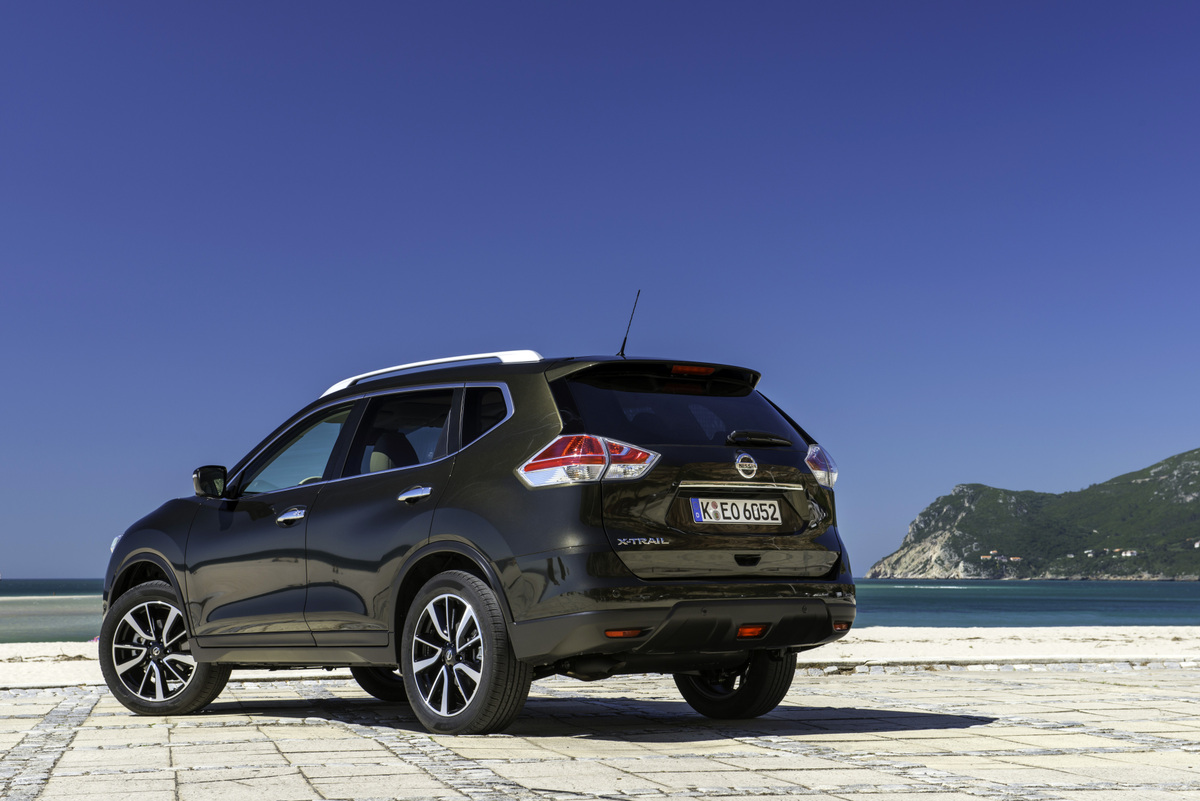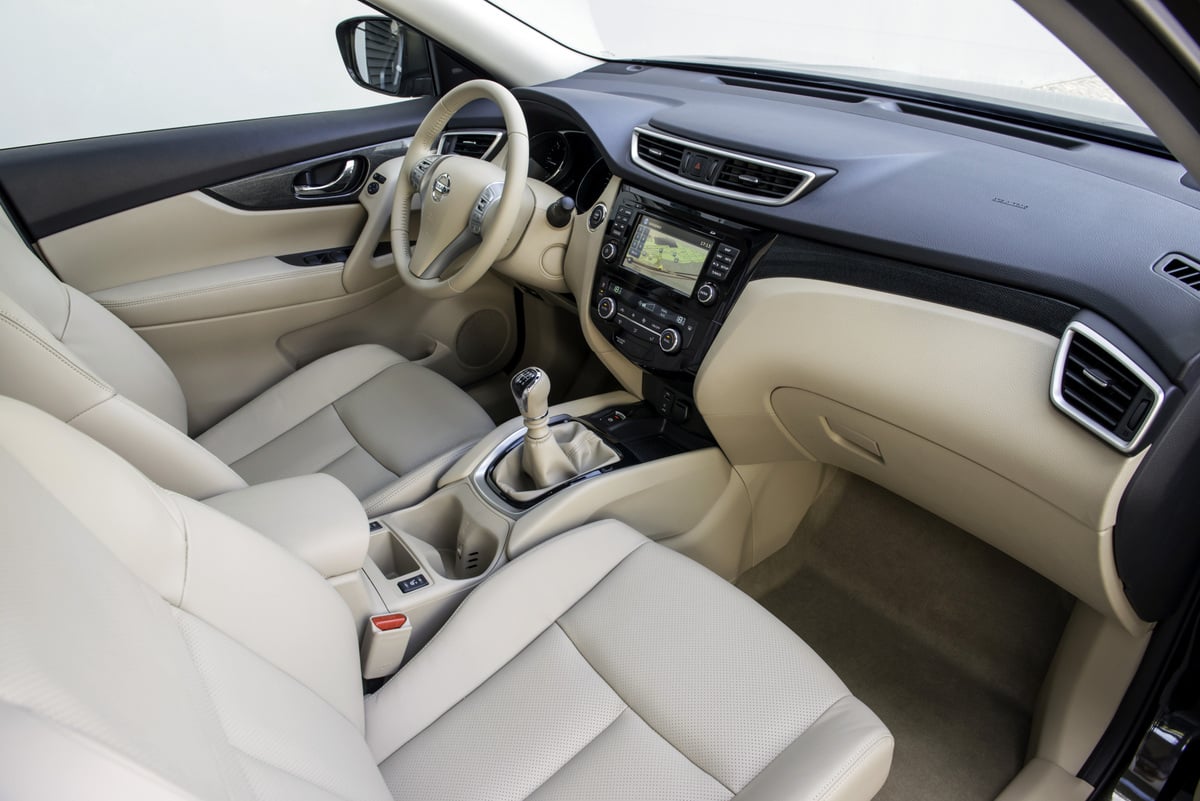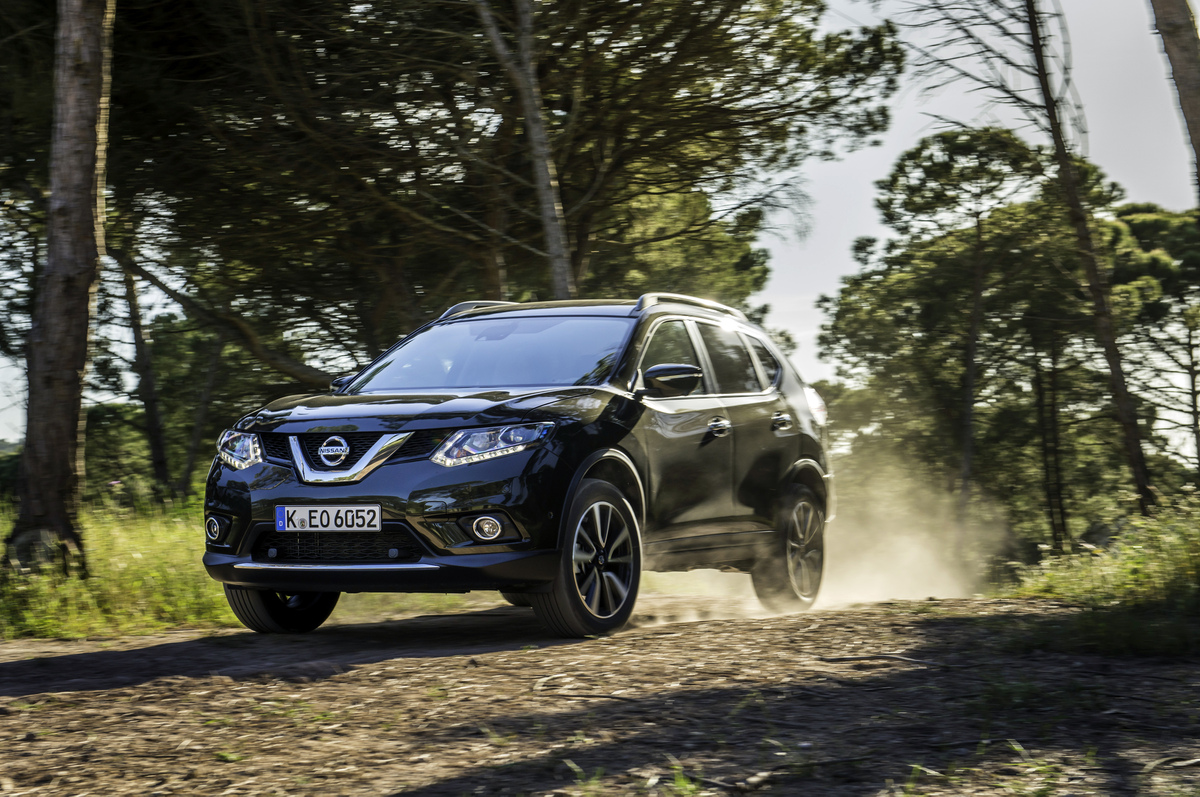
Cheaper than AA or we’ll beat by 20%^
• Roadside cover from £5.49 a month*
• We get to most breakdowns in 60 mins or less
• Our patrols fix 4/5 breakdowns on the spot

The Nissan X-Trail is an ideal used SUV option if the Qashqai appeals but you need more space. But is it a good overall buy? Lawrence Allan takes a look.
Things you'll like
- Easy, car-like driving experience
- A solid option for families
- Well-equipped for the money
Things to consider
- There are roomier alternatives
- Performance is only adequate
- Seven seats were optional
History: What is the 2014-2017 Nissan X-Trail?
It feels like a different age, but back in 2007 Nissan turned the concept of the SUV (Sports Utility Vehicle) on its head. It recognised that the motoring masses were admiring the presence and practicality of SUVs but were woefully short of options that were affordable to buy and run.
Then the Qashqai was launched, and the rest is history. SUVs made up 60% of all new cars registered in 2023, and most of those were affordable mainstream offerings with two-wheel drive – and it’s the Qashqai that started the craze. But what about the Nissan X-Trail?
When the first Qashqai began flooding dealers Nissan had a well-established SUV in the Mk2 X-Trail. It was an SUV of the old-school, with a squared-off look and a focus on off-roading and towing. When the time came to launch the new, third-generation X-Trail, the changing market dictated a shift towards a more road-biased, family-friendly offering.
With the Qashqai’s huge global success, this Mk3 X-Trail was launched in 2014 alongside the closely related Mk2 Qashqai. This X-Trail didn’t just replace the outgoing model, it also superseded the not particularly popular Qashqai +2 with seven seats optionally available.
Its soft-roader underpinnings and curvy design may have put off mud-plugging fans of the old car, but this new X-Trail brought in a whole new audience who needed big car space, but one much like the Qashqai to look at, sit in and drive.
A decade on, though, does the Mk3 Nissan X-Trail make a good used SUV purchase? Or is it one to avoid? We’ll find out in this in-depth used review.
Verdict: is the Nissan X-Trail a good car?
We reckon the X-Trail is a solid used purchase if you’re after a well-priced, economical, spacious and safe family SUV. There are faster, better-driving and more desirable options out there, but most command a substantial price premium, so the Nissan looks like good head-over-heart family transport for the money.
Specs and used pricing
While the original X-Trails were resolute 4x4s with some two-wheel drive options, the Mk3 was a front-wheel drive car with some 4x4 versions higher up the range. You’ll find less than a third of used X-Trails for sale are four-wheel drive as a result.
Two engines were offered in the 2014-2017 X-Trail. The most popular (and therefore most numerous on the used market) is the 130hp 1.6 dCi diesel – the sole engine offered at launch. It could be had with a six-speed manual gearbox or Xtronic CVT automatic, with only the former having a four-wheel drive option.

A manual-only 1.6 DIG-T turbo petrol engine with 163hp was also offered from 2015 onwards, and that was your lot until the 2017 facelift brought along a much-needed more powerful 2.0-litre diesel.
In terms of equipment, entry-level Visia features LED running lights, 17-inch alloys, Bluetooth connectivity, DAB radio, air-con, four electric windows and cruise control, along with a five-inch touchscreen infotainment system.
Mid-spec Acenta adds features like front fog lights, an upgraded six-speaker stereo, parking sensors, a panoramic sunroof and auto lights and wipers. Acenta Premium further upgrades the car with a larger seven-inch touchscreen, sat-nav and a 360-degree camera system.
N-Connecta (previous called N-Tec or N-Vision) upgrades the alloy wheels to 18-inches while also bringing kit such as an electric tailgate and keyless start. Finally, top-spec Tekna throws in LED headlights, leather trim, electric and heated front seats, 19-inch alloys and a self-parking system.
One thing worth bearing in mind is that seven seats were never standard fitment, even on top-spec trims. They were optional across the range, and only around 20% of used X-Trails for sale have them specified.
Pricing-wise, you’ll find high mileage mid-spec models starting from under £5,000, but a budget of £7,500 gives you a pick of tidier, higher-spec models with less than 100k on the clock. Automatics tend to be rarer and command a premium, as do versions with seven seats or four-wheel drive.
Rivals
The X-Trail has a host of used alternatives – some with five seats and some with seven. Similarly sized and priced five-seat rivals include the Toyota RAV4, Honda CR-V and Mazda CX-5, while you might also consider posher options such as the Volkswagen Touareg and Volvo XC60.
If you’re determined to get seven seats, it’s well worth also checking out the Kia Sorento and Hyundai Santa Fe. Early versions of the excellent Skoda Kodiaq should be just within budget, too, while consider MPV options like the original Peugeot 5008 and Ford S-Max.
Interior and practicality
The X-Trail’s front-end design isn’t the only bit that bears more than a passing resemblance to the Qashqai – the interior layout appears to be identical.
By the standards of the day it’s a pretty good cabin, if visually a bit drab. It’s solid and hard-wearing with a reasonable amount of soft-touch finishes – you’d hardly call it plush, but is that necessary for an affordable family bus?
The layout itself is more cause for praise. All the buttons and switchgear is exactly where you expect it to be, and the climate control stack embarrasses many modern SUVs with its ease-of-use. The driving position is comfortable and widely adjustable, too, with good seat comfort.
Where the X-Trail shows its age most is with the touchscreen infotainment system. The tiny five-inch display of entry-level versions is best avoided, with the seven-inch screen more usable on the move. Neither are great, however, with old-school graphics and little in the way of smartphone connectivity beyond Bluetooth. At least they’re easy to operate with plenty of physical shortcuts.

Passenger space, storage and boot space
Function over form is the order of the day with the X-Trail, so while there might be more upmarket alternatives it’s a very practical family hauler.
Small details like generous storage compartments and wide-opening rear doors (great for loading your offspring in and out) make the X-Trail a useful day-to-day companion, but it’s the outright passenger space that matters most. There’s an extra 6cm in the wheelbase (the space between the front and rear wheels) compared to the Qashqai - which is hardly cramped itself.
In the front or middle row there’s lots of head and legroom even for taller adults, while those in the middle can recline the backrests or slide the whole seat forwards or back to juggle legroom with boot space.
You’ll need to slide those seats forwards in cars fitted with the optional third row of seats if you actually intend to use them, as they’re the only part of the X-Trail that isn’t spacious. Only small adults can fit in them despite the reclining backrests, and even then it’s best for a short lift home. Those seats are ideal for a pair of children, however, and on a par with the Skoda Kodiaq’s for space – if smaller than the Santa Fe’s.
Bear in mind that you’ll seriously compromise the boot with that third row of seats erected, too. But they do stow easily into the boot floor, revealing a useful 550-litre space that swells to just under 2,000 litres with all five seats stowed away. The clever adjustable boot floor can be positioned in a variety of ways to separate luggage, too.
What is a used Nissan X-Trail like to drive?
Nissan focused on making this generation of X-Trail a more competent on-road performer, while still retaining some (if not all) of the old car’s mud-plugging ability. That’ll probably suit most buyers.
For what is a relatively large car the X-Trail is easy to drive around town thanks to light steering, good forward visibility and a lightweight manual gearbox. The X-Tronic CVT automatic also comes into its own in town, feeling smooth thanks to the lack of discernible gearchanges.
Out of town the X-Trail offers a decent drive, but its handling is no highlight. It’s a bit more ponderous than a Qashqai thanks to the extra bulk, but despite a fair bit of body roll it’s competent enough for a car of this type. The CVT gearbox is best avoided if you enjoy driving – it blunts performance and makes a racket when you try to get up to speed.
The ride is generally comfortable thanks to soft suspension, but models with the largest wheel options can be unsettled over lumps and bumps around town. Up the speed and it’s well-judged, with decent cruising manners. Nevertheless, a Skoda Kodiaq is more composed overall.
You won’t notice too much difference between two and four-wheel drive models on the road, but the latter is obviously more capable off the beaten track. It’s no Land Rover, but rutted tracks and muddy car parks shouldn’t prove a problem in the X-Trail.
Engines
Most X-Trails you’ll find on the used market are equipped with the 130hp 1.6-litre four-cylinder diesel engine. It’s found homes in various Renaults and Nissans over the years and it’s a decent unit.
Don’t be put off by its modest power output – with 320Nm of torque and a 0-62mph time of 10.5 seconds it’s gutsy enough for everyday driving, while also being relatively smooth and rattle-free. It can feel a bit out of its depth in a car this large, however, and the CVT gearbox option blunts performance further.
The alternative is the rarer 1.6 DIG-T four-cylinder turbo petrol engine. With 163hp and a 0-60mph time of 9.7 seconds it’s faster than the diesel on paper, but you lose 80Nm of torque – which makes all the difference. You need to work the engine to get the best out of it, which is a bit at odds with the car’s relaxed demeanour. The diesel is also a more effective tow car – something which matters as the X-Trail is popular with caravanners.

Ownership, running costs and reliability
It’s no coincidence that the diesel proved more popular for new buyers of the X-Trail - its efficient for a car of this type, particularly in two-wheel drive manual form.
In this most frugal specification it promises up to 57.6mpg combined. Although that’s on the old, less realistic NEDC cycle, it’s considerably better than a comparable Sorento or Santa Fe. You’ll lose a few MPG off this figure with 19-inch alloys, the X-Tronic gearbox or four-wheel drive, however.
The petrol only managed around 44mpg on the NEDC cycle in its most frugal, which is a considerable drop not really justified by its slight refinement advantage. For road tax you’ll pay £160 annually for diesels and £190 for petrols.
The X-Trail starts from insurance group 15 for the lowest-spec diesels to group 20 for the top-spec petrol, which is good for a car of this size. It’s on a par with the Skoda Kodiaq and considerably lower than alternative like the Kia Sorento or Toyota RAV4 – thank the modest performance for that.
In terms of reliability, there aren’t any major horror stories to report, but there are things to look out for. The diesel engines are generally sturdy but reports suggest the diesel particulate filter (DPF) can clog up prematurely. Cars mainly used for short journeys are most susceptible to this. Oil leaks have been reported, too.
The petrol engine doesn’t have many reported issues, although that could be due to its rarity. Generally, you’ll want to check all the interior tech works properly and the trim hasn’t been damaged by unruly children – this is a family SUV after all. Cars that have been used for towing may suffer increased wear to the rear suspension, clutch and dual-mass flywheel.
As always a full service history is desirable, while checking the condition of consumables such as brake discs and pads, and the age of the car battery, can help avoid future headaches.
Euro NCAP: is a used Nissan X-Trail a safe car?
The Nissan X-Trail was praised by safety body Euro NCAP in 2014, being awarded the maximum five-star crash test rating with strong occupant and pedestrian protection scores, making it a safe family SUV option when compared to other used SUVs for the same money.
Every X-Trail features six airbags, stability and traction control, tyre pressure monitors and a speed limiter. Nissan’s Chassis Control system also gently tweaks the brakes when cornering to keep you stable.
Higher spec models were equipped with Nissan’s ‘Safety Shield’ features such as autonomous emergency braking, lane departure warning, traffic sign recognition and blind spot monitoring – all of these are desirable features if fitted. Auto lights and wipers, combined with parking sensors and even a 360-degree parking camera system, can be found on certain versions.
Nissan X-Trail FAQs
Is the Nissan X-Trail a good car to buy?
The Mk3 Nissan X-Trail is a good all-round family SUV for those than need a larger boot than a Qashqai, or the option of seven seats. It’s well-equipped, economical and easy to drive, but there are alternatives with more power and more space in the rear two rows of seats.
Is the Nissan X-Trail a 4x4?
While the first two generations of Nissan X-Trail were designed with 4x4 driving at its core, the 2014-on Mk3 model was more of a road-biased SUV. It was offered with four-wheel drive as an option across the range, but only with an automatic gearbox – and most versions you’ll find for sale are front-wheel drive.
What are the differences between the Qashqai and X-Trail?
The Nissan X-Trail is effectively a stretched version of the Qashqai with seven seats instead of the Qashqai’s five. The X-Trail is 10cm longer, as well as being slightly taller and wider, to accommodate this extra space.










![Hyundai Santa Fe [NC] (2012 - 2017) used car review](https://d1gymyavdvyjgt.cloudfront.net/drive/images/made/drive/images/remote/https_d2yv47kjv2gmpz.cloudfront.net/filestore/9/6/4/1_5ce2fc0b768bc27/6f29bd33729d9c24bac34fe0ac66f4bf/1469_ed724e30b16abbf_100_100_70_c1_c_c.jpg)